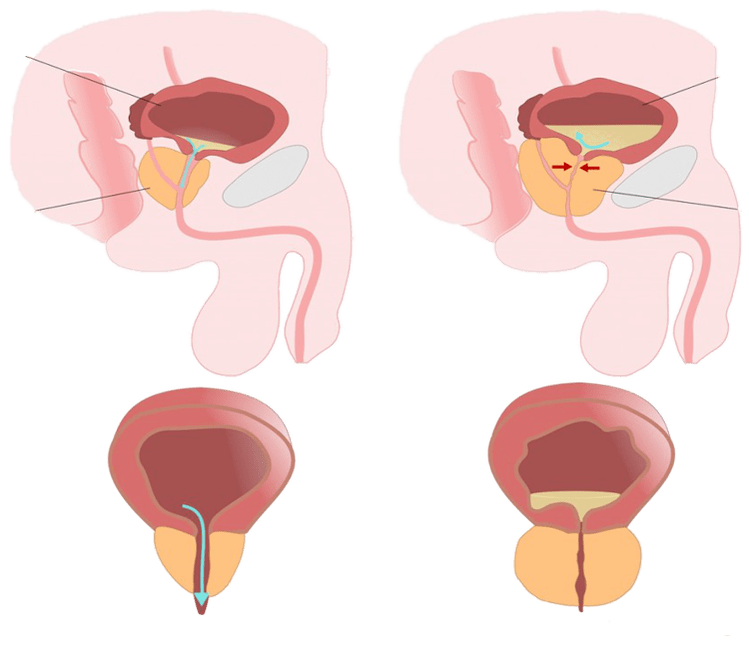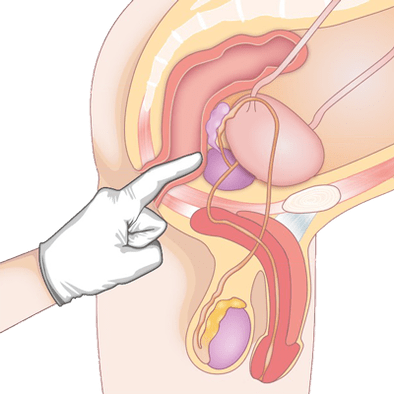
Diseases of the genitourinary system in men are difficult to treat and are recurrent in nature. Prostate pathologies affect hormonal levels, emotional state, erectile and genitourinary function.
Treatment of prostatitis in men is complicated by the fact that in the early stages of development, disorders practically do not manifest themselves symptomatically. The first signs appear when the disease is advanced. Early diagnosis and correctly prescribed therapeutic treatment are the key to a favorable prognosis in the fight against pathology.
What is prostatitis
With few exceptions, the term "prostatitis" refers to chronic or acute inflammation of the prostate. The manifestations of prostatitis in men are similar to the symptoms of other pathologies of the genitourinary system. The process leads to obstruction of glandular tissues and the appearance of the following disorders:
- Dysuric disorders.
- Decreased sexual desire.
- Erectile dysfunction.
- Pain syndrome.
The disease causes the formation of adhesions and scars. Metabolism and blood circulation in tissues gradually deteriorate. Irreversible changes occur and can only be corrected with surgery. There are several types of disorders depending on the etiology and stage of development.
Categories of prostatitis
Inflammation of the prostate matures against the background of congestion in the pelvic region. The process quickly becomes chronic. The favorable time for treatment is the early stage of the disease.
Medical reference books describe 4 types of disease, with characteristic symptoms and manifestations:
- Category I—Acute prostatitis.The catalyst is an infection that has penetrated the tissues, injury and hypothermia of the gland. The inflammation occurs suddenly and lasts 3 to 4 days. Without the necessary treatment, it becomes chronic. Events:
- heat,
- fever,
- pain in the pelvis and lumbar region,
- intoxication of the body.
- Category II—Chronic bacterial prostatitis.It starts with an exacerbation. Cause of appearance: interrupted antibiotic treatment, self-medication. Inflammation occurs in a latent form, without visible manifestations, until the immune system weakens to the point that the infection triggers an exacerbation of the disease. Treatment begins with antibiotics and NSAIDs.
- Category III—Chronic prostatitis/chronic pelvic pain syndrome (CP/CPPS).A disease mutated from acute inflammation of the prostate. Disturbances develop slowly, irreversible changes occur, leading to tissue obstruction. Congestive inflammation, for its part, is divided into two subgroups:
- Category IIIa - Chronic prostatitis/chronic pelvic pain syndrome with signs of inflammation.It is characterized by pronounced manifestations: mild fever, increasing during an exacerbation to 38-38. 5°. Characteristic symptoms of male prostatitis: deterioration of erection, hemospermia, prolonged sexual intercourse without orgasm, impaired urination.
- Category IIIb - Chronic prostatitis/chronic pelvic pain syndrome without signs of inflammation.In this case, the manifestations are diagnosed exclusively using instrumental research methods.
- Category IV—Asymptomatic (asymptomatic) chronic prostatitis.It is a poorly understood disease whose etiology is incompletely understood. Some renowned urologists have suggested an age-related cause of the disease. There are no symptoms of pathology.

It is difficult to cure prostatitis, even at an early stage. To achieve stable remission, it will be necessary to eliminate the causes - catalysts, to deal with the complications and consequences arising from them.
Why is prostatitis dangerous?
Prostate inflammation is a serious pathology that affects men's health. Possible complications and consequences of the disease:

- erectile dysfunction- scars and adhesions, resulting from inflammation, prevent normal blood circulation in the cavernous vessels. At the same time, the prostate's ability to process testosterone deteriorates. Sexual desire decreases. In the acute period, friction and ejaculation cause pain. All of the above causes erection to deteriorate. In some cases, complete sexual impotence is diagnosed.
- Infertility— Chronic inflammation not only affects the prostate, but also spreads to adjacent parts and organs of the genitourinary system. Degenerative disorders often manifest at the level of the ligament: testicles + glandular tissues. The quality and volume of spermatogenesis deteriorate. Getting pregnant by a man with advanced prostatitis is problematic.
- Development of associated diseases- the inflammation can spread to neighboring organs of the genitourinary system:
- urethral canal,
- bladder,
- kidneys,
- scrotum
- The death— the danger of death exists in the event of a purulent disease. If treatment of acute male prostatitis does not begin on time and purulent formations appear and turn into abscesses, the patient's life is in danger. A rupture of the cavity towards the rectum causes general poisoning and can lead to death.
In severe conditions, surgical intervention is necessary. Unlike adenoma or malignant hyperplasia, surgery is extremely rarely prescribed and does not guarantee the prevention of relapses.
Which doctor treats prostatitis
It all depends on the manifestations of the disease. The urologist remains the main one. It is this specialist who deals with pathologies of the male genitourinary system, including inflammation of the prostate. In case of violations, it will be necessary to seek help from doctors of another specialization.

Current clinical guidelines indicate the need to promote:
- Psychiatrist— help is needed if pain and other manifestations create psychological rejection of sexual relations, impotence without physical disorders.
- Immunologist— Long-term antibacterial and drug treatment causes a severe blow to the body. Protective functions and the ability to resist infection are reduced. Some forms of prostatitis begin with autoimmune diseases. In each of these situations, the help of an immunologist will be necessary.
- Surgeon— opening purulent abscesses, performing TUR, prostatectomy and removal of calcifications are carried out by a specialist. The help of a surgeon will be required to eliminate adhesions of the seminal canals and restore reproductive function.
Such a number of specialists necessary for the complete cure of the patient convincingly proves that it is impossible to cure prostatitis on your own, let alone get rid of complications. Qualified assistance is required.
How to recognize prostatitis
The insidious nature of the disease lies in the fact that for a long time the inflammation develops asymptomatically in a latent form. The first signs of prostatitis are often attributed to: fatigue, radiculitis, diseases of the genitourinary system. The pain stops after taking an analgesic or antispasmodic tablet. But inflammation of the prostate continues until the problems become global. A man goes to the doctor, where he receives an unpleasant diagnosis.
However, the most effective way to get rid of prostatitis remains early diagnosis and immediate treatment. The chance of complete recovery is around 80%.
To differentiate inflammation from other diseases, several diagnostic tests are performed:

- Rectal method— the doctor probes the structure of the gland by inserting a finger into the anus, which makes it possible to identify possible anomalies and deviations.
- Ultrasound and TRUS— Ultrasound diagnosis remains the research standard due to its low cost and availability. The monitor shows a loose structure of the gland, indicating inflammation; it is possible to detect calcifications and other signs of prostatitis.
- Clinical and biochemical tests of blood and urine- show the presence of inflammation, and also identify an infectious agent.
- Spermogram- decreased vitality and speed of spermatozoa, characteristic signs of congestive prostatitis and obstruction of glandular tissues. Bacteria and pathogens are found in the ejaculate during infectious disease.
- MRI and PET-CT- the most reliable diagnostic methods. Due to its high cost, the examination is prescribed only if the results of previously performed tests are unclear, as well as if cancer is suspected.
Tomography reveals signs of prostatitis in the early stages, inaccessible with other diagnostic methods. If abnormalities in the functioning of the prostate are suspected, MRI remains the preferred type of instrumental examination.
How long does it take to process
Stories of miraculous deliverance in a few days are nothing more than tales. There is no quick way to treat prostatitis. After diagnosing inflammation, you must adapt to long-term treatment and drastic changes in your eating habits and lifestyle. Only in this case will it be possible to defeat the disease.
Modern and effective methods of treating prostatitis have made it possible to shorten the duration of treatment. With an integrated approach, significant improvements can be achieved within 2 to 3 months.
Doctors have learned to deal with the consequences of prostatitis. Unique therapeutic methods help eliminate infertility, restore normal erection and increase sexual desire.
After achieving stable remission, you will need to regularly take medicinal plants, attend physiotherapy sessions for prevention purposes, and maintain men's health in other ways.
How is prostatitis treated?
There is no effective pill after which all unpleasant symptoms will disappear. Among traditional medicine, there is no miraculous cure either. The best methods of treating prostatitis in men with proven effectiveness include an integrated approach: medications + physiotherapy + unconventional methods.
Official medicine offers conservative treatment. After completing the course, unpleasant symptoms and negative manifestations of the disease disappear. In the second stage, the task is to eliminate the complications that have arisen.
Advanced non-invasive methods have increased the chances of a favorable outcome of the disease. Surgery is only necessary in 10 to 15% of cases.
With the help of medications
Conservative treatment is carried out to eliminate the symptoms. The following groups of drugs are prescribed:

- NSAIDs- relieve inflammation, heat and fever. They have a mild analgesic effect. When prostatitis begins, short-term treatment with anti-inflammatory drugs and vitamins is necessary to keep the gland in a normal state. The drugs are available in the form of suppositories, tablets and injections.
- Antibiotics- designed to eliminate infectious or bacteriological inflammatory factors. The treatment regimen for prostatitis is prescribed after the pathogen has been identified and tested for antibiotic resistance. The duration of treatment is 7 to 10 days. In severe cases, treatment is extended for up to two weeks.
- Hormones- recommended if the usual drug treatment has not brought any benefit, as well as in cases of decreased sexual desire due to advanced illness. Hormonal treatment in the early stages is prohibited. Medicines are taken under the strict supervision of a urologist.
- Symptomatic medications— to eliminate pain, take acetylsalicylic acid tablets. Spasms are eliminated by an antispasmodic agent. In case of severe and persistent pain, blocking with an anesthetic is indicated.
- Vitaminsand medications to maintain prostate function. During the period of remission, it is recommended to take medications to normalize metabolism and improve blood supply to glandular tissues and juice production. For this purpose, medicinal plants are prescribed. To strengthen the immune system, a vitamin and mineral complex is indicated.
Self-medication is dangerous and does more harm than good. Before taking any of these medications, you should consult a urologist.
Use physiotherapy
Prostatitis is characterized by significant congestion in the pelvic region, which significantly complicates treatment. Taking medications turns out to be ineffective, because the active components simply cannot be delivered through the blood vessels to the prostate.
To increase the effectiveness of drug treatment, immediately after the relief of the exacerbation, physiotherapy is included in the treatment of prostatitis in men.
In addition to traditional electrophoresis, the following techniques are prescribed:
- UHF and microwave.
- Magnetotherapy.
- Mud therapy.
- Galvanization.
- Ultraphonophoresis.
- Laser treatment.
- Thermal therapy.
Most of the listed procedures are included in the set of techniques used in spa treatments. Contraindications to physiotherapy remain: period of acute inflammation, development of tumor tumors, individual intolerance in the patient.
Natural remedies
Modern methods of treating prostatitis increasingly combine official methods and alternative medicine. In ancient times, our ancestors treated prostatitis with infusions, decoctions and bee products. The disease itself did not disappear, but the unpleasant symptoms were relieved.
Some methods have survived to this day:
- Apitherapy— bee products are used to eliminate inflammation and strengthen the immune system. Honey is a natural antibiotic. Used in treatment: death, propolis, wax, pollen, poison. Compresses and massages with honey, tinctures are performed.
- Herbal Collections- urological compounds are sold in pharmacies and you can prepare them yourself. Herbs treat urinary disorders, relieve inflammation and relieve pain. Some plants are good antiseptics. Decoctions and teas are prepared from the collections, and added when preparing compotes and tinctures.
In the past, there were no hospitals or pharmacies. Illnesses were treated with the gifts of "Mother Nature". After prescribing a drug treatment, the urologist will certainly recommend one of the alternative medicine recipes: herbal medicine or apitherapy.

Only an integrated approach to the fight against prostatitis will allow you to get rid of the disease once and for all. The success of treatment depends on early diagnosis and scrupulous compliance with the urologist's recommendations.























